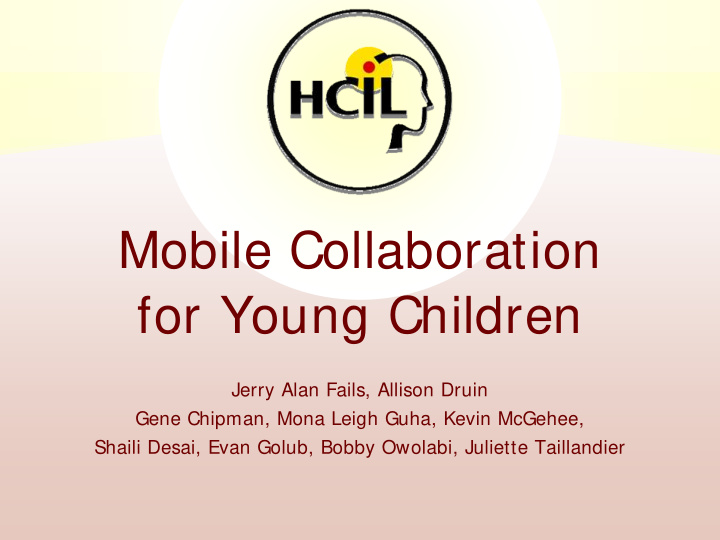



Mobile Collaboration for Young Children Jerry Alan Fails, Allison Druin Gene Chipman, Mona Leigh Guha, Kevin McGehee, Shaili Desai, Evan Golub, Bobby Owolabi, Juliette Taillandier
Children are mobile!!! Why Mobile? Inside the house Where have you been?
Two heads are better than one Why Collaboration? The whole is greater than the sum of its parts
Mobile Collaboration � Availability � Important for social and cognitive development � Bridges physical and traditional computing � Can support constructionism � Ability to create in � Expanded user interface context Young Children � Increasing population � Increasing usage of mobile devices � Personal expertise
Mobile Collaboration To work together, especially in a joint intellectual effort. (www.dictionary.com) Spatial Co-located Distributed Different Same Place Temporal Synchronous Place, & Time Same Time Same Place, Different Asynchronous Different Place & Young Children Time Time Ages 6-10
Move Beyond … � Devices for consumption/entertainment/collection � To make mobile devices more: – Collaborative – Child-appropriate – Creative, generative, constructive � Kidsteam � Cooperative Inquiry (Druin, CHI 1999; Guha et al., IDC 2004)
Prototype System – Mobile Stories � Stories and Scenes – Picture – Text – Sound � Client/server model – Changes propagated to each device – Over 802.11
Pilot Study � At Fort McHenry National Park � Children create collaborative story � Purpose – Directly observe children’s collaboration – Further the design process
Evolution of a Shared Scene Changed … 12:21 Picture 12:25 Text 12:27 Picture 12:31 Text 12:32 Picture 12:33 Picture 12:34 Picture 12:35 Picture 12:37 Picture
Face-to-Face Collaboration
Co-present Mobile Collaboration � Space-sharing � Content-splitting � Sharing interactions – Navigation/focus – Editing – Copying/trading � Bumping (Hinckley, 2003) � Tossing (Yatani et al., 2005) � Stitching (Hinckley et al., 2004) Ciconia Ciconia (White Stork) by Andrea Petrlik published 2003, Kašmir Promet – Croatia, Available in the International Children’s Digital Library (ICDL)
Take Home Message � Many ways to collaborate � Interfaces need to support several ways � Mobile devices need new interfaces and interactions to support these interfaces Mobile Collaboration for Young Children Educational learning The way mobile devices are used
Questions Acknowledgments Kidsteam National Park Service Microsoft www.cs.umd.edu/hcil/mobilestories/ fails@cs.umd.edu fails@cs.umd.edu
� Availability � CSCW / CSCL � Interactions – Wood et al., 2005 – Greenberg, 1991 – Hua et al., 2005 – UPI, 2005 – Tandler et al., 2001 Mobile Collaboration – Hinckley, 2004, 2005 � Grids/ad-hoc networks – Gartner, 2005 � Paradigms – Sacramento et al., 2004 – Hirst, 2006 – Winer & Ray, 1994 – Lima et al., 2005 � Control – John-Steiner, 2000 � Context-aware – Davidyuk et al., 2004 – Myers et al., 2004 � Systems – Griswold et al., 2004 � Digital library – Google Docs & – Hull et al., 2004 Spreadsheets 2006 – Bell et al., 2006 – Buyukkokten et al, 2000, 2001, 2002 – MS Office Groove � Require Collaboration 2007 – Zurita & Nussbaum, 2004 � Development – Benford et al., 2005 – Vygotsky, 1978 � Device initiatives � Collection � Design – OLPC – Rogers et al., 2004 – Druin et al., 1999 – Classmate PC – Broderson et al., 2005 – Mobilis – Guha et al., 2004 Young Children � Narrative systems – Halloran et al., 2006 � System – Sketchy (goknow.com) – Cole & Stanton, 2003 – StoryBeads (Barry, 2000) � Development � Learning theory � Narrative systems – Piaget, 1971 – Dewey, 1916 – MOOSE Crossing (Bruckman, 1997) – Piaget, 1973 � Increasing population – PETS (Plaisant et al. 2000) – Vygotsky, 1978 – www.census.gov/ipc/ – SAGE (Umaschi & Cassell, 1997) www/idbpyr.html – Papert, 1980, 1991 – StoryMaker (SpaSoft, 2005)
Collaborative Play
Research Approach (Design) � Kidsteam � Cooperative Inquiry (Druin, CHI 1999; Guha et al., IDC 2004)
Formative Research � Physical vs. virtual (Fails et al., IDC 2005) → Mobile devices could bridge the divide � Tangible Flags (Chipman et al., IDC 2006) → Collaboration, organizing collections � Collections – Kids collect but do not (want to) organize → Implicit organization via narratives � Mobile Stories (Fails, IDC 2007) – Design sessions with Kidsteam – Fort McHenry National Park → Mobile collaboration
Children are mobile Inside the Where have you been? house
Children are mobile Collaboration is important to the social and cognitive development of children → Mobile Collaboration for Young Children
Mobile Collaboration for Young Children Educational learning Educational learning The way mobile devices are used The way mobile devices are used
Context for Research Mobile Stories Children Collaborate Collaboratively Construct Construct Collaborate Children’s Stories Children Stories in Mobile Settings Construct Stories Mobile
Summary / Take Home Message � Mobile collaboration is important
Tangible Flags � Started breaking down the collaborative barriers � Allowed mobility and knowledge construction � Demonstrated the importance of construction/creation in context and collaboration (Chipman et al., 2006)
Audio Data Collection Mobile Children’s Stories Constructionism Collaboration
Construction Mobile Children’s Stories Constructionism Collaboration
Research Approach (Evaluation) � Formative comparative study of interfaces – Within subject – Counter-balanced � Field, case study – Focus on collaboration – Multiple data collection methods � Technology logs, video, field notes, interviews/questionnaires, collaborative stories How do collaborative mobile technologies affect children’s collaboration?
ICDL � International Children’s Digital Library � www.childrenslibrary.org
Prototype Limitations (2 of 2) � No integrated camera � Range of wireless (for collaboration) � Interface – Screen space – Simple scene/page paradigm
Children are mobile Collaboration is important to the social and cognitive Inside the development of children house → Where have you been? Mobile Collaboration for Young Children
Recommend
More recommend